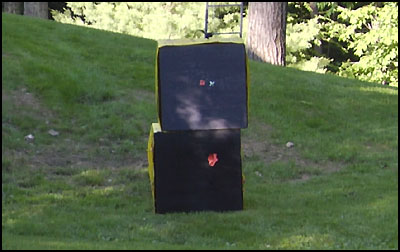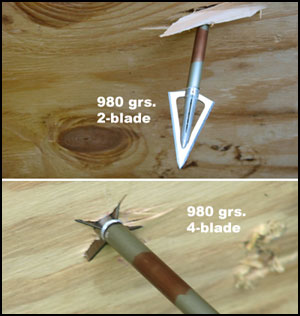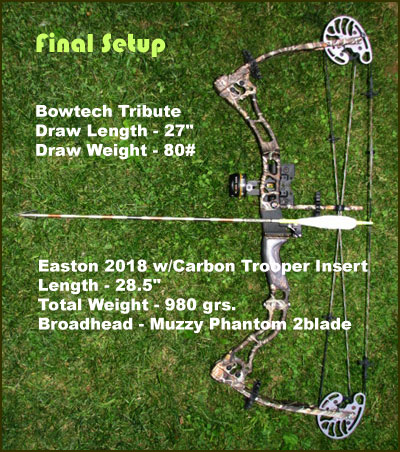*actual arrows were Chronographed at Hall’s Archery in Manchester Ct.
The Tests
I’d like to say that the test I conducted used scientific measuring devices under controlled environments. But given that a buffalo is not a controlled environment, I opted for a simple set up of simply shooting through ¾” plywood lashed to a foam target. While the plywood does not accurately simulate the ribs of a cape buffalo, it would provide me with the answers I was looking for, and that was:
I basically performed 3 sets of tests:
· Flight
· Accuracy
· Penetration
The objective for these tests was to answer the following questions:
- How does the broadhead stand up to the shot, to repeated shots
- Penetration difference between a 2-blade and 4-blade broadhead
- How well does the heavy arrow penetrate
- How well does the lighter arrow penetrate
- What type of arrow flight can I achieve with my test arrows
- What type of accuracy can I achieve with my test arrows
I performed these tests over the course of 8 days. The tests were performed as a process of elimination. If I could not get the arrow to fly straight, it did not go on to the accuracy portion, if the flight was good, but accuracy suffered, the arrow did not go onto penetration testing, etc. I kept notes and filmed all of my results.

Watch The Video - Flight Test (600k)
Flight Tests - My first test was the flight tests with no penetration testing included. This test was critical to me. A heavy arrow with high Kinetic Energy will lose penetrating power if the broadhead is not hitting squarely behind the shaft. All the energy should be directly behind the broadhead. Poor arrow flight will divert energy away from the point and that energy will work against forward momentum and that greatly diminishes penetration. This test was performed by simply recording the arrow flight from my 4 test arrows. I filmed the flight using my new Panasonic HVX200 HD camera which can shoot High Def at 60 progressive frames per second. This is twice the speed of a normal video camera and 3 times the speed of a typical movie camera. When viewed in slow motion, the results were inconclusive except for one difference. On my two heavy arrows, my 4-fletch flew slightly better than my 3-fletch with no loss in feet/per/second (FPS) speed for the first 20 yards. (Side note: I had no intention of testing a 4-fletch arrow, I had simply configured my fletching jig incorrectly and by the time I realized it, it was too late. So I finished off my first heavy arrow as a 4-fletch and corrected the mistake for my second heavy arrow).
Conclusion - All four arrows flew well with no significant vertical porpoising or horizontal movement detected. The Gold Tip weighting system created a more difficult arrow to tune, but I was able to find the sweet spot. Once tuned, any of the four arrows, even the heaviest arrow flew very well.
Accuracy Test - this was a lot more difficult to judge, and it required constant tuning, setup and attention to my rest/spine as well as sighting in my bow with every test. But the results were conclusive. I am more accurate with a lighter arrow setup after 25 yards. But within 25 yards my shots were generally within a 3” circle every time regardless of the arrow. The heavy arrows created a steep trajectory curve that increased dramatically after 30 yards. If I was asked to make a 40 yard shot on a buffalo, then this test would be over, but since I am not a long-range shooter, and my PH feels confident that a 20 yard shot was achievable, I kept my heavy arrows in the mix and moved on to the final penetration testing.
Conclusion - Within 25 yards accuracy was acceptable for all arrows. Given the fact that my accuracy with the lighter arrows was improved, and the Gold Tips produced less KE than my lighter arrows, I decided to eliminate the Gold Tips from my penetration tests.
2-Blade Penetration Testing - With 3 of 4 arrows still remaining, the ultimate test was to see how well my arrows would penetrate when shot into a fresh sheet of ¾” thick plywood. All shots were performed at 15 yards into a fresh section of plywood. This was important since structural cracks from one test could influence subsequent tests. For that reason I shot at least 3 arrows within each test.
Watch The Video - Penetration Test 1 (600k)
Watch The Video - Penetration Test 2 (700k)
Watch The Video - Penetration Test 3 (1.2mb)
The results were dramatic immediately. The 980 grain 3 and 4 fletch completely penetrated through the plywood in all tests and gave me a statistical confidence level since all penetrations were between 4.5” - 6.2” of penetration beyond the opposite side of the plywood. The lighter arrows never fully penetrated the plywood and would become lodged into the wood requiring us to drill them out.
Conclusion - The heavy arrow had dramatically better penetration than the lighter arrow. The lighter arrow has been eliminated.
4-Blade Penetration Testing - With no discernible difference between the 3 and 4 fletch arrows (arrows 1 and 2) the last test was to see the difference between a 2 blade vs. a 4 blade broadhead. We achieved this test by using a fresh Muzzy Phantom only this time we left the additional 2-blade inserts attached to the head where previously we had remove them. This changed the weight slightly from 980 grains to an even 1000 grains and lowered the speed to 183 fps for a total KE of 74, down 1 ft. lb from our 2-blade setup (statistically insignificant).

The tests were conclusive immediately - the same arrow shooting a 4-blade Muzzy Phantom never penetrated the plywood. Basically, we achieved the same level of penetration with our light, 2-blade arrows as we did with our heavy 4-blade arrows.
Conclusion - the heavy arrow shooting a 4-blade configuration dramatically reduced penetration compared to the 2-blade head.
With all tests completed and the results identified, we answered all of our questions:
- How did the broadhead stand up to the shot, to repeated shots? - The Muzzy Phantom never bent of deformed once during any of our penetration tests. However we did ruin 3 of them while digging them out of the plywood with power tools which was no indication of the heads’ performance. As suspected, the Muzzy Phantom is an extremely reliable and sturdy head - one of the best I’ve ever seen. Check out these photos
- Penetration difference between a 2-blade and 4-blade broadhead? - The results were dramatic, the 2 blade out-penetrated the 4 blade every time by a wide margin. In fact, the 4 blade results were the same as the 2-blade, light arrow results.
- How well did the heavy arrow penetrate? - in the 2-blade configuration, the heavy arrow penetrated well with our 80lb bow, however not in the 4-blade configuration.
- How well does the lighter arrow penetrate? - Poorly, it was eliminated as an option.
- What type of arrow flight can I achieve with my test arrows? - Acceptable with all our test arrows after tuning. Interestingly, the 4-fletch achieved better flight than the same arrow with a 3-fletch configuration - with no speed loss within 20 yards.
- What type of accuracy can I achieve with my test arrows? - All arrows were acceptable given my personal abilities until 25 yards, after that arrows 1 and 2 decreased my accuracy and at 40 yards the results were dramatic.
And the Winner Is?
The arrow configuration which we chose for our upcoming Buffalo hunt is the Easton 2018 with a Carbon Trooper Arrow glued inside the shaft. The Broadhead will be a Muzzy Phantom SS (2-blade) and the arrow will be fletched in a 4-fletch configuration.

Shaft Weight - 780 grs
Broadhead Weight - 200grs
Total Weight - 980 grs
Speed - 186 fps
Kinetic Energy - 75 ft/lbs.
= 1 Dead Cape Buffalo, hopefully